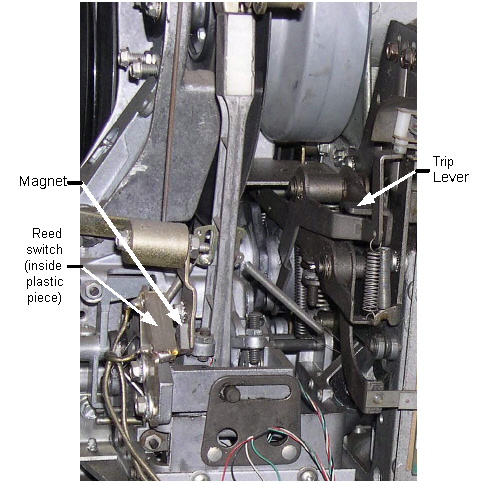 This could be a mechanical or an electrical problem. The first thing to do is to figure out which it is. Watch how the mechanism cycles. Just to the right of the pickup arm you will see a lever, with an elongated slot. This is the trip lever, as you can see in the photo at left. It flips up each time the trip solenoid energizes, to pick up a record for play, or to put it back in the magazine once play is complete. Put your finger on this lever, and apply a light pressure in the downward direction. CAUTION! There will be 120 Volts on several of the switches in the close vicinity of this lever, so be careful not to get a shock! Note that applying too much downward pressure may cause the trip lever to correctly move, resulting in normal record play. As the lever moves when incorrectly tripping, you may feel a buzzing on the lever. This indicates that it is an electrical problem (see the next paragraph). If there is no buzzing, it probably means that the clutch shifting lever is gummed up due to aging lubrication, and the mechanism needs to be degreased and fresh lubrication applied. Your machine's manual includes a lubrication chart. For those wanting to degrease and re-apply lubrication, I recommend you get Ron Rich's Seeburg Mechanism Guide, for tips from his forty years of Seeburg jukebox experience.
This could be a mechanical or an electrical problem. The first thing to do is to figure out which it is. Watch how the mechanism cycles. Just to the right of the pickup arm you will see a lever, with an elongated slot. This is the trip lever, as you can see in the photo at left. It flips up each time the trip solenoid energizes, to pick up a record for play, or to put it back in the magazine once play is complete. Put your finger on this lever, and apply a light pressure in the downward direction. CAUTION! There will be 120 Volts on several of the switches in the close vicinity of this lever, so be careful not to get a shock! Note that applying too much downward pressure may cause the trip lever to correctly move, resulting in normal record play. As the lever moves when incorrectly tripping, you may feel a buzzing on the lever. This indicates that it is an electrical problem (see the next paragraph). If there is no buzzing, it probably means that the clutch shifting lever is gummed up due to aging lubrication, and the mechanism needs to be degreased and fresh lubrication applied. Your machine's manual includes a lubrication chart. For those wanting to degrease and re-apply lubrication, I recommend you get Ron Rich's Seeburg Mechanism Guide, for tips from his forty years of Seeburg jukebox experience.
Switch S1103 is the switch mounted to one side of the Pickup Arm Cradle Frame. It closes when the pickup arm reaches the lead-out groove of the record, to begin the transfer cycle to put the record back into the magazine. If this switch is shorted, or the cabling between it, the reject switch in the Volume Control Assembly, optional PRVC, or the Mute Trip Relay in the Amplifier is grounded this can occur. To check for this, turn the power off and manually put the mechanism in play with a record on the turntable. Turn the motor coupling until the pickup needle just sets down, and rotate the coupling a few turns more to insure that the mechanism is completely in play while observing the movement of the 3M12 and 3M11 contacts. Make sure that 3M11 opens before 3M12 closes. If not, perform the appropriate adjustments as listed in the mechanism manual. 
Don't have a manual? You can get a copy from: Always Jukin', Victory Glass, or Stamann Musicboxen for those in Europe.
class="F4 Bold FontArial Black"